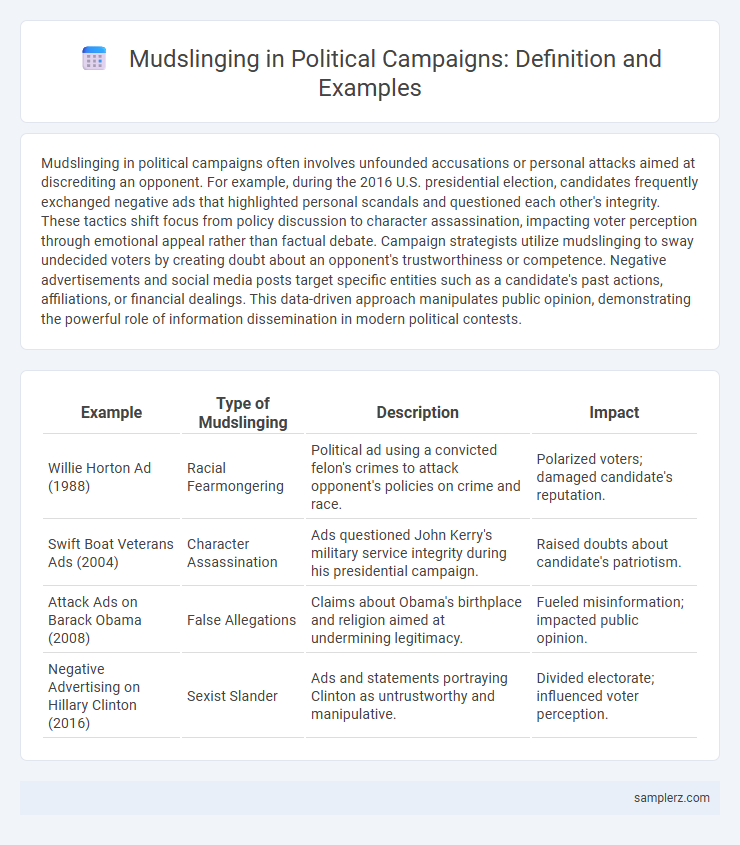Mudslinging in political campaigns often involves unfounded accusations or personal attacks aimed at discrediting an opponent. For example, during the 2016 U.S. presidential election, candidates frequently exchanged negative ads that highlighted personal scandals and questioned each other's integrity. These tactics shift focus from policy discussion to character assassination, impacting voter perception through emotional appeal rather than factual debate. Campaign strategists utilize mudslinging to sway undecided voters by creating doubt about an opponent's trustworthiness or competence. Negative advertisements and social media posts target specific entities such as a candidate's past actions, affiliations, or financial dealings. This data-driven approach manipulates public opinion, demonstrating the powerful role of information dissemination in modern political contests.
Table of Comparison
| Example | Type of Mudslinging | Description | Impact |
|---|---|---|---|
| Willie Horton Ad (1988) | Racial Fearmongering | Political ad using a convicted felon's crimes to attack opponent's policies on crime and race. | Polarized voters; damaged candidate's reputation. |
| Swift Boat Veterans Ads (2004) | Character Assassination | Ads questioned John Kerry's military service integrity during his presidential campaign. | Raised doubts about candidate's patriotism. |
| Attack Ads on Barack Obama (2008) | False Allegations | Claims about Obama's birthplace and religion aimed at undermining legitimacy. | Fueled misinformation; impacted public opinion. |
| Negative Advertising on Hillary Clinton (2016) | Sexist Slander | Ads and statements portraying Clinton as untrustworthy and manipulative. | Divided electorate; influenced voter perception. |
Defining Mudslinging in Political Campaigns
Mudslinging in political campaigns refers to the strategic use of negative advertising and personal attacks to damage an opponent's reputation, often involving accusations of dishonesty, corruption, or moral failings. This tactic aims to sway voter perception by highlighting opponents' weaknesses rather than policy differences. Notable examples include the 1968 U.S. presidential campaign where Richard Nixon's team employed aggressive smears against Hubert Humphrey to undermine public trust.
Historical Examples of Mudslinging Tactics
Historical examples of mudslinging tactics in political campaigns include the 1828 U.S. presidential race where Andrew Jackson's supporters labeled John Quincy Adams a corrupt aristocrat, significantly damaging his public image. The 1964 U.S. presidential election saw Lyndon B. Johnson's campaign portray Barry Goldwater as an extremist, using the infamous "Daisy" ad to invoke fear of nuclear war. These tactics often rely on personal attacks, misinformation, and emotional manipulation to undermine opponents and sway voter sentiment.
Famous Modern Campaigns Known for Negative Attacks
The 2016 U.S. presidential campaign between Donald Trump and Hillary Clinton was marked by relentless mudslinging, with attacks targeting personal character, business practices, and alleged corruption. Negative advertisements and viral social media posts fueled public distrust and polarized voters, exemplifying how modern campaigns leverage mudslinging to manipulate public perception. This campaign highlighted the strategic use of smear tactics to disrupt opponents' credibility and dominate media coverage.
Types of Mudslinging Used in Elections
Mudslinging in political campaigns often includes tactics such as character assassination, false accusations, and negative advertising aimed at discrediting opponents. Attack ads exploit voters' emotions by highlighting scandals or personal flaws, while rumor-mongering spreads unverified information to create doubt. These strategies manipulate public perception and can significantly influence election outcomes by shifting attention from policy debates to personal controversies.
Impact of Mudslinging on Voter Perception
Mudslinging in political campaigns often distorts voter perception by emphasizing negative traits over policy issues, leading to increased cynicism and voter disengagement. Studies indicate that exposure to negative ads can depress turnout by eroding trust in all candidates, ultimately benefiting incumbents or lower-profile candidates. The pervasive use of character attacks shifts public discourse away from substantive debate, undermining democratic decision-making processes.
High-Profile Debates Marked by Character Smears
High-profile political debates frequently become battlegrounds for character smears, where candidates launch personal attacks instead of focusing on policy issues. During the 2020 U.S. presidential debates, aggressive mudslinging targeted candidates' past decisions and personal histories, diverting public attention from substantive discussion. Such tactics often undermine the democratic process by prioritizing sensationalism over informed voter engagement.
Media Amplification of Mudslinging Claims
During political campaigns, media amplification often escalates mudslinging claims, making derogatory accusations more pervasive and influential among voters. Sensational headlines and repeated coverage by major news outlets, such as CNN and Fox News, intensify public exposure to negative rhetoric, shaping voter perceptions and potentially swaying election outcomes. This phenomenon demonstrates the powerful role of media in magnifying smear campaigns and influencing democratic processes.
Legal and Ethical Boundaries in Campaign Attacks
Campaigns often cross legal boundaries by disseminating false information that can lead to defamation lawsuits, highlighting the importance of adhering to election laws governing truthfulness in political advertising. Ethical boundaries are breached when candidates engage in personal attacks or spread unverified rumors aimed at damaging opponents' reputations instead of focusing on policy differences. Regulatory bodies like the Federal Election Commission enforce restrictions to maintain fairness and integrity, but the challenge remains to balance robust political discourse with respect for legal and ethical standards.
Notable Mudslinging Incidents in Local vs. National Races
Notable mudslinging incidents in local races often involve personal attacks and grassroots misinformation, such as the 2018 Virginia governor's race where false claims about candidate Ralph Northam's past circulated widely. In contrast, national races feature high-profile smear campaigns leveraging media and social platforms, exemplified by the 2008 U.S. presidential election between Barack Obama and John McCain, where both campaigns accused each other of unethical behavior. These different scales of mudslinging tactics highlight how local campaigns rely more on direct voter engagement, while national contests exploit broader media reach for influence.
Countering Mudslinging: Strategies for Damage Control
Campaign teams employ rapid response units to counter mudslinging by immediately addressing false allegations and presenting verified facts to maintain candidate credibility. Leveraging social media platforms allows for real-time engagement with voters, correcting misinformation and reframing negative narratives effectively. Strategic deployment of positive messaging and third-party endorsements helps dilute the impact of mudslinging while reinforcing the candidate's core policy strengths.

example of mudsling in campaign Infographic
 samplerz.com
samplerz.com